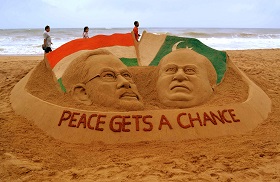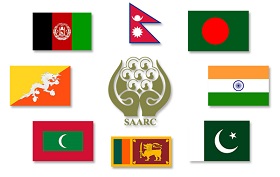On November 26, 2014, Nepal’s capital Kathmandu hosted the 18th SAARC Summit. After three years without a meeting, this was a landmark event in the political environment in South Asia. However, traditional differences between the two regional leaders – India and Pakistan – nearly torpedoed the Summit. Should this multilateral organization be analyzed from the perspective of the complex India-Pakistan relations, or should it be considered a solid platform for solving economic problems in the region? Vyacheslav Belokrenitskiy, Doctor of History, Deputy Director of the RAS Institute of Oriental Studies, Professor of MGIMO-University Oriental Studies Department and RIAC expert, shares his insights on the situation.
On November 26, 2014, Nepal’s capital Kathmandu hosted the 18th SAARC Summit. After three years without a meeting, this was a landmark event in the political environment in South Asia. However, traditional differences between the two regional leaders – India and Pakistan – nearly torpedoed the Summit. Should this multilateral organization be analyzed from the perspective of the complex India-Pakistan relations, or should it be considered a solid platform for solving economic problems in the region? Vyacheslav Belokrenitskiy, Doctor of History, Deputy Director of the RAS Institute of Oriental Studies, Professor of MGIMO-University Oriental Studies Department and RIAC expert, shares his insights on the situation.
How would you comment on the Summit held by the member states of SAARC? What problems were discussed? What steps will be taken by the countries in the future?
The SAARC summit (the South Asian Association for Regional Cooperation) is a landmark event in the political life of the countries in South Asia. The eighteenth Summit was held after a three-year break, as the previous Summit took place in Addu, the Maldives, in the fall of 2011. It should be noted, that a three-year break was quite unusual for the organization's activities in recent years. This was probably due to the fact that almost all of the countries in South Asia conducted elections in 2012-2014. The last elections were held in the largest country in the region, India, in May 2014. In 2013, elections were held in Pakistan, Bangladesh, the Maldives and Nepal. Since the last summit, all the countries, with the exception of Sri Lanka, have gone through a period of a changing of the guard and shifts in the dominant political parties and forces.
The eighteenth Summit in Kathmandu became a meeting place for new people. This is a significant event due to the fact that the summit was attended by leaders of all eight member states of the organization. Afghanistan joined the South Asian Association as its eighth member state in April 2007 and was represented at the Summit by newly elected President Ashraf Ghani.
The new people at the head of the new governments participated in joint discussions of issues and projects. The South Asian Association does not deal with issues of bilateral cooperation. Taking them off from the table has been a strict rule for the 30 years of SAARC existence. The organization’s first high-level meeting took place in December 1985. Since then, 18 summits have been held as well as numerous meetings at the level of foreign ministers and deputy foreign ministers. So far the organization has failed to make any great advances, which was recognized by the participants of the Summit, in particular by the Nepalese side that hosted the meeting.
The South Asian Association for Regional Cooperation yields to ASEAN significantly in terms of importance and the role in the life of the region and world politics. ASEAN is a major regional trade and economic bloc, known for its internal and external links with its neighbors, including Europe. It is the core of multilateral diplomacy in Southeast Asia and the Asia-Pacific region. SAARC has been unable to perform this kind of function. The organization is better known for its declarative statements. It cannot boast having achieved great success in the trade and economic spheres, but does play an important role as a platform for meetings between the leaders of the region’s countries who have experienced rather strained relations between them.
The main axis of confrontation is the continual infighting between the two nuclear powers in the region, namely India and Pakistan. The participants of the meeting noted that the organization has become a victim of the controversial Indo-Pakistani relationship. Difficulties in the Indo-Pakistani relations have weakened the organization and blunted its effectiveness. The newly elected leaders of India and Pakistan met in Kathmandu for the second time.
Narendra Modi represents the new ruling party and coalition in India and is known for his tough enough Hindu nationalist position and views. Modi is a very colorful and quite mobile political figure. He promises to place India on a new track and carry out reforms to spur the economic and social development of the country, making it a great power in terms of international and domestic political realities. He is quite a colorful figure on the South Asian political horizon.
On the other hand, Nawaz Sharif was the undisputed winner of the parliamentary elections in 2013 in Pakistan, whose current position of dominance in the parliament of Pakistan is about the same as Narendra Modi’s in the Indian Parliament. Nawaz Sharif was elected a year and a half ago. His power as prime minister has been somewhat weakened by the crisis that hit Pakistan in August-September 2014. Until now, the crisis is not yet over, but it cooled somewhat and is now not so acute. Be as it may, Nawaz Sharif is a very charismatic personality in Pakistani politics as well. Thus, the relationship between the two traditional antagonists continues to dominate politics in South Asia.
The meeting in Kathmandu was held in a format that made many observers doubt its efficiency and expediency, but at the very last moment, when the participants entered an informal setting, Narendra Modi and Nawaz Sharif shook hands. This was a good sign. However, border skirmishes between India and Pakistan in August-October 2014 prevented the launch of the diplomatic process for regularizing relations. The process of normalizing diplomatic relations was wrecked and has not yet been resumed. It is difficult to assess now the impact of the Summit on the development of relations between India and Pakistan. Most likely, dialogue between the two countries is unlikely to yield significant results in the immediate future.
Narendra Modi attaches great importance to establishing links with his South Asian neighbors. He had one-on-one discussions with all the leaders of South Asian countries, except Pakistan, since the leaders of both countries did not want to be the first to express interest in one-on-one talks. Currently the intensity of emotions has somewhat decreased. Most likely, a new phase will be connected to the elections which took place on November 25, 2014 in the Indian state of Jammu and Kashmir. Kashmir is a controversial issue in the relations between the two countries. The results of these elections will largely determine the vector of further development of their future relationship.
If we speak about SAARC in terms of trade and economic opportunities, the results are not really impressive, although, given the good will and commitment of all participants, they could be significantly enhanced. Summit participants were expected to sign an agreement on the creation of unified energy, railway and highway transportation systems. However, of the three projects, they managed to sign a memorandum on only energy cooperation between all the countries in the region, with a view of creating a unified power grid in the future. Power supplies are a sore point for many countries, and creating such a common pool may play a decisive role in an economic revival.
Given appropriate political conditions and a favorable political situation, these objectives can be achieved. Countries in the region can help each other to make economic progress and develop their economies. The planned projects would increase trade among all countries and create a common basis for promoting trade and the economic development of the region. The prospects for connecting transmission grids, as well as road and railway networks, look quite promising, but the question is how to make them a reality. Unfortunately, at the present time, public opinion in the two antagonistic countries of India and Pakistan has forced the respective governments to follow the lead of extremist patriotic elements.
The leaders attending the Kathmandu Summit did their best to not cause resentment and dissatisfaction in public opinion in their home countries. Both Narendra Modi and Nawaz Sharif had to act with caution, always keeping in mind possible reactions to their actions back home. Therefore, the Summit did not fully justify the hopes that had been set on it, but the process continues. The next summit will be held in Islamabad in 2016.
Interviewer: Maria Gurova, RIAC Program Manager





